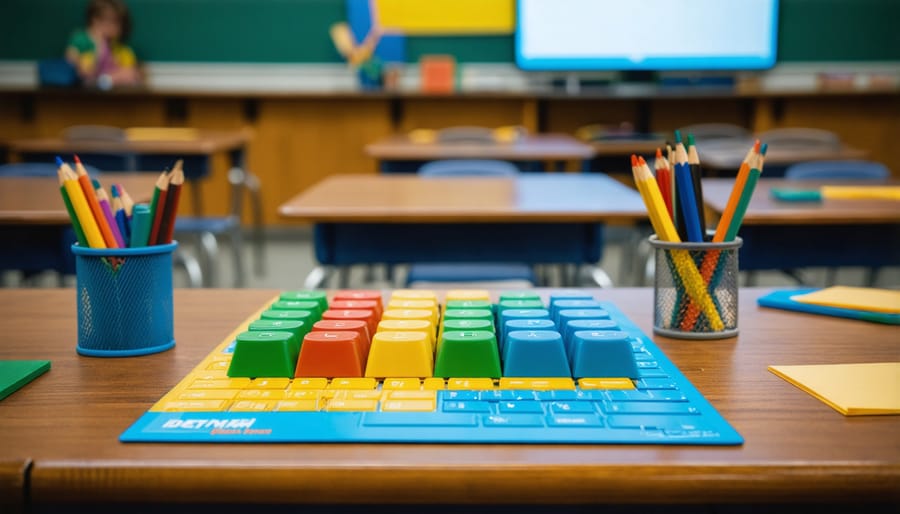Turn Assessment Into Your Secret Weapon for Classroom Management
**Transform Assessment Into Your Secret Weapon for Student Engagement and Classroom Control**
Picture this: Students racing to answer questions, cheering each other on, and *actually asking* for more quizzes. Sound impossible? It’s happening in classrooms right now through gamified assessment techniques that turn evaluation from a dreaded event into the highlight of your lesson.
Traditional assessments often trigger anxiety and disengagement, but when you add game elements—points, levels, team challenges, and instant feedback—you create an environment where students willingly showcase their knowledge. The magic happens because games tap into natural motivations: the thrill of competition, the satisfaction of progress, and the joy of achievement.
Here’s what makes gamification transformative for assessment: it gives you real-time data on student understanding while simultaneously improving behavior. When students are genuinely engaged in a quiz game, classroom management issues virtually disappear. No more students staring at blank papers or disrupting others—they’re too busy strategizing their next move.
The best part? You don’t need coding skills or hours of preparation. Today’s digital tools offer customizable game templates that let you turn any assessment into an interactive experience in minutes. Whether you’re checking understanding of multiplication facts or analyzing literary themes, game-based assessments adapt to your content and grade level.
Ready to discover specific techniques that make assessment both effective and exciting? Let’s explore practical strategies you can implement tomorrow—starting with methods that require zero technology and advancing to digital games that students will beg to play.
Why Traditional Assessments Fall Short in Managing Today’s Classrooms
We’ve all been there—handing out a traditional test and watching the energy drain from the room. Students shift nervously in their seats, some freeze up completely, while others rush through just to be done. The irony? The very tools we use to measure learning often create the biggest classroom management headaches.
Traditional assessments weren’t designed with today’s diverse learners in mind. When students face high-stakes tests or repetitive worksheets, anxiety kicks in. That test anxiety doesn’t just affect scores—it triggers behavioral issues. Fidgeting increases, students check out mentally, and some act out as a coping mechanism. You end up managing stress responses instead of facilitating learning.
Then there’s the disengagement factor. Standard testing formats offer zero flexibility for different learning styles or paces. Your kinesthetic learners feel trapped, creative thinkers have no outlet, and students who need extra processing time feel rushed and defeated. This disconnect between assessment methods and how students actually learn best creates a perfect storm for behavioral problems.
The aftermath is equally challenging. When tests get returned, you’re managing disappointment, frustration, and sometimes tears. Students who struggle begin associating assessment with failure, leading to avoidance behaviors and resistance to future evaluations.
Here’s the reality: if your assessment approach causes more management issues than it solves, it’s time to rethink your strategy. Effective student engagement strategies recognize that assessment and classroom management aren’t separate challenges—they’re interconnected. When students feel engaged and motivated during assessments, behavioral issues naturally decrease. The solution isn’t abandoning assessment altogether but transforming how we approach it to work with student psychology, not against it.

The Power of Gamified Assessment for Dual-Purpose Teaching
Gamified assessments are like hitting two birds with one stone—they give you accurate insights into student learning while keeping your classroom buzzing with positive energy. When you transform traditional quizzes into game-based experiences, you’re tapping into something powerful: students’ natural love for play and competition.
Here’s the secret sauce behind why this works so well. Games trigger our brain’s reward system, releasing dopamine when students answer correctly or level up. This creates an instant feedback loop that keeps them motivated and focused. Unlike traditional tests that might cause anxiety, classroom management games feel more like entertainment than evaluation, reducing stress while maintaining academic rigor.
The psychology is straightforward—when students perceive an activity as a game rather than a test, their defensive walls come down. They’re more willing to take risks, participate actively, and even learn from mistakes without feeling defeated. This shift in mindset transforms your assessment time from a dreaded event into an anticipated activity.
But here’s where it gets even better: while you’re gathering valuable data about who understands the material and who needs extra support, you’re simultaneously managing classroom behavior. Students engaged in game-based assessments are naturally on-task, reducing disruptions and off-topic chatter. The game format provides clear structure and expectations, which helps students stay focused.
The best part? You can customize these games to match your specific learning objectives and classroom dynamics. Whether you need a quick formative check-in or a comprehensive unit review, game-based assessments adapt to your needs. You’re not just assessing knowledge—you’re creating an environment where learning feels rewarding, behavior stays positive, and you get the assessment data you need to guide instruction effectively.

Gamified Assessment Techniques That Work in Real Classrooms
Team-Based Review Games with Built-In Accountability
Transform your review sessions into exciting competitions using PowerPoint game templates! These digital games combine assessment with teamwork, creating an environment where students naturally encourage each other to succeed.
**Smart Team Formation Strategies**
Mix ability levels intentionally when creating teams. Pair stronger students with those who need support—this builds cooperation and ensures everyone contributes. Keep teams to 3-4 members for maximum participation. Random selection tools or strategically pre-assigned groups both work well depending on your classroom dynamics.
**Built-In Accountability Features**
The magic happens when peers motivate peers! Team-based games create positive pressure because students don’t want to let their teammates down. Each member becomes invested in everyone’s understanding. Rotate who answers questions so everyone stays alert and prepared.
**Effective Score Tracking Tips**
Display scores prominently on your board or screen throughout gameplay—visible progress fuels excitement! Use PowerPoint’s animation features to reveal point totals dramatically. Consider bonus points for collaboration behaviors like helping teammates or showing good sportsmanship.
Popular game templates include Jeopardy-style boards, quiz shows, and race-to-the-finish formats. The best part? You can customize questions to match any subject or skill level, making these games work for your specific curriculum needs. Students stay engaged because they’re having fun while demonstrating what they’ve learned—and you’re gathering valuable assessment data without the traditional test anxiety!
Point Systems That Motivate Without Causing Chaos
Point systems transform everyday classroom activities into exciting opportunities for growth! The key is designing scoring that motivates everyone, not just your top performers. Start by establishing clear, achievable criteria—students should always understand exactly how they’re earning points.
Create multiple pathways to success. Award points for improvement, effort, collaboration, and creativity alongside traditional achievement. This ensures every student can contribute and feel valued. Display your scoreboard prominently, but consider team-based scoring rather than individual rankings to encourage peer support instead of cutthroat competition.
Keep things fresh by rotating point values for different skills weekly. Maybe this week collaboration earns double points, while next week focuses on creative problem-solving. This variety maintains excitement and highlights diverse talents across your classroom.
Balance is everything! Combine your point system with positive reinforcement techniques that celebrate specific behaviors and achievements. Set reasonable point thresholds for rewards—if goals feel impossible, motivation crashes quickly.
Remember to periodically reset scores or offer “comeback challenges” so students who fall behind don’t disengage. The best point systems create momentum and inclusion, turning assessment into something students actually look forward to participating in rather than dreading.
Quick-Fire Quiz Games for Formative Assessment
Quick-fire quiz games are your secret weapon for keeping students engaged while you check for understanding without missing a beat. These fast-paced formats turn formative assessment into an energizing classroom moment rather than a momentum killer.
Think of games like “Around the World,” where students compete in rapid-fire fact recall, or digital versions where everyone answers simultaneously on devices. The speed element keeps focus sharp and behavior positive—there’s simply no time for students to drift off-task when answers fly every 30 seconds!
**Customization is key** to making these work across subjects and ages. For younger elementary students, use image-based questions with colorful visuals and simpler vocabulary. Middle schoolers thrive on competitive team formats where they can collaborate on slightly tougher content. High school classes often appreciate individual leaderboards that track progress over time.
Subject-specific tweaks make all the difference too. Math teachers can use number challenges or equation races, while language arts classes benefit from vocabulary lightning rounds or grammar quick-checks. Science? Try identification games with diagrams. History teachers love timeline ordering challenges.
The beauty of quick-fire formats is their flexibility—run them as warm-ups, lesson breaks, or exit tickets. Most importantly, you’ll gather instant data on who gets it and who needs more support, all while maintaining that positive, engaged classroom atmosphere that makes teaching enjoyable.
Puzzle-Based Assessments for Deeper Thinking
Puzzles aren’t just for fun—they’re brilliant assessment tools that reveal how students think through problems! When you transform traditional assessments into brain-teasing challenges, you’re measuring critical thinking, pattern recognition, and problem-solving skills while keeping engagement levels sky-high.
Try using logic puzzles to assess math concepts. For example, create Sudoku-style grids where students must arrange fractions in correct order, or design crossword puzzles using vocabulary terms with clues that require definition recall and context application. These formats naturally align with standards for reasoning and application.
Escape room-style challenges work wonderfully for multi-step problem solving. Students must solve sequential puzzles—each answer unlocking the next question—demonstrating their ability to build on prior knowledge. This format assesses everything from reading comprehension to scientific method application.
The beauty of puzzle-based assessments? They’re endlessly customizable to your curriculum! Tie them directly to your standards by designing riddles around historical events, creating pattern-matching games for grammar rules, or building mystery scenarios that require students to apply recently learned concepts.
Best of all, students often don’t realize they’re being assessed. They’re too busy enjoying the challenge, which means you get authentic demonstrations of their understanding without test anxiety clouding the results!
Board Game-Style Assessments for Extended Learning
When you need to assess broader learning objectives or complete unit reviews, board game-style formats offer the perfect solution. These longer activities keep students engaged through multiple rounds while giving you comprehensive insights into their understanding.
Transform traditional review sessions into game board adventures where students advance by answering questions correctly. Think digital or paper paths with themed spaces—each landing spot presents a new challenge. The structured turn-taking naturally manages classroom behavior since everyone knows when they participate.
The beauty of board game assessments lies in their flexibility. Customize question difficulty based on learning objectives, mix in bonus challenges for critical thinking, and adjust the game length to fit your schedule. Students stay motivated throughout because the game format makes even lengthy assessments feel like fun competition rather than testing pressure.
These games work wonderfully for both individual accountability and team collaboration. Assign roles within groups to ensure everyone contributes, or use individual game boards where students progress at their own pace. Either way, you’re gathering valuable assessment data while students remain focused and enthusiastic.
The structured gameplay keeps your classroom organized—students understand the rules, follow the sequence, and stay engaged from start to finish. Plus, you can reuse the same game template across different units by simply swapping out questions!
Setting Up Your Gamified Assessment System for Maximum Impact
Ready to bring game-based assessments into your classroom? Start by establishing clear boundaries that keep the excitement high while maintaining structure.
Begin with simple, transparent rules. Before launching your first game, explain how earning points works, what behaviors you expect, and how winning connects to demonstrating knowledge. Students thrive when they understand the system, so consider creating a visual rulebook or anchor chart they can reference anytime.
Time management is crucial for preventing chaos. Set specific time limits for each game segment—maybe 10 minutes for a quick review quiz or 20 minutes for a more complex challenge. Use timers that students can see, and practice transitioning smoothly between game mode and regular instruction. This predictability helps students stay focused rather than overly excited.
Your physical classroom setup matters too. Decide whether students will compete individually, in pairs, or in teams. Arrange seating to support collaboration while minimizing distractions. If you’re using digital games, ensure devices are ready and charged before class begins to avoid technical delays.
Start small with classroom gaming fundamentals before diving into elaborate systems. Choose one simple game format, master it with your students, then gradually introduce new variations. This approach builds confidence for both you and your class.
Customize point values to match your assessment goals. Reward not just correct answers but also teamwork, respectful competition, and creative problem-solving. This balanced approach keeps games purposeful rather than purely competitive.
Finally, debrief after each game. Spend three minutes discussing what students learned and how the game helped them understand the material. This reflection transforms fun activities into meaningful assessments that stick.
Customization Strategies That Match Your Teaching Style
The beauty of game-based assessments lies in their incredible flexibility—you can mold them to fit your unique classroom vibe! Start by thinking about what makes your students tick. Teaching elementary math? Transform a basic quiz template into a space adventure where each correct answer launches them closer to a friendly alien planet. High school history? Turn review sessions into time-travel challenges where teams compete to “unlock” different historical periods.
Grade level adaptations are simpler than you might think. For younger students, incorporate more visuals, colorful themes, and immediate rewards like animated celebrations. Older students often appreciate sophisticated point systems, team competitions, and real-world connections that make the content feel relevant to their lives.
Don’t forget to inject your personality into the games! If you’re big on humor, add funny sound effects or quirky character names. Prefer a calm classroom? Choose soothing color schemes and gentle background music. The key is authenticity—students respond when they see *you* reflected in the learning experience.
Subject-specific tweaks make all the difference too. Science teachers can create lab-themed game boards, while language arts teachers might design story-based quests. Math classes benefit from timed challenges, and social studies work perfectly with map-based games. The best part? Once you’ve customized a template you love, save it as your go-to format and simply swap out the questions for different units. This approach saves precious planning time while keeping assessments fresh and exciting!

Troubleshooting Common Challenges
Even the best gamified assessments can hit a few bumps along the way, but don’t worry—these challenges are totally manageable with the right approach!
**When Competition Gets Too Intense**
Some students take winning very seriously! If you notice tensions rising, pause the game and remind everyone that the real goal is learning, not just points. Try switching to team-based games where students support each other rather than compete individually. You can also adjust scoring systems to reward improvement rather than just top performance. For more strategies on managing competitive behavior, consider incorporating collaborative challenges where everyone wins together.
**Keeping Noise Levels in Check**
Excitement is great, but too much noise disrupts learning. Set clear expectations before starting any game—use a visual signal like a raised hand when volume needs to drop. Consider “silent games” where students respond digitally or on paper, or designate certain rounds as “whisper mode” to maintain energy while controlling sound.
**Ensuring Assessment Accuracy**
Worried games won’t give you reliable data? The key is aligning game questions directly with your learning objectives. Use customizable templates to create questions that truly test understanding, not just quick reflexes. Track individual responses, not just team scores, and follow up games with brief reflection questions to gauge deeper comprehension.
**Technology Troubles**
Tech issues happen! Always have a backup plan—keep printed versions of game questions ready or prepare a non-digital alternative. Test your games before class, ensure devices are charged, and teach students basic troubleshooting steps. Remember, even a tech hiccup can become a teachable moment about flexibility and problem-solving!
Gamified assessments truly are the perfect solution for tackling two of your biggest classroom challenges at once—getting accurate insights into student learning while keeping everyone engaged and on-task. When students are excited about demonstrating what they know, behavior issues naturally fade into the background, and you get the meaningful data you need to guide your instruction.
The beauty of this approach? You don’t need to overhaul your entire assessment system overnight. Start small and build your confidence along the way. Choose just one game template that fits your next assessment—maybe a quick quiz show format for vocabulary review or a digital board game for end-of-unit concepts. Customize it with your content, test it out, and watch what happens. You’ll likely notice students who usually disengage suddenly paying attention, and that one student who always finishes early now invested in the challenge.
As you see the positive impact, you’ll naturally want to explore more game formats and find creative ways to weave them throughout your assessment routine. Each small success builds momentum, and before you know it, your classroom culture shifts from assessment anxiety to assessment excitement.
Ready to transform your classroom environment? Pick one upcoming assessment this week and give it a gamified twist. Your students—and your stress levels—will thank you for it!


